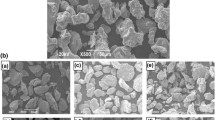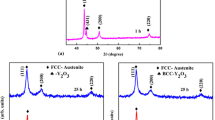Abstract
A new technique, Spray-Dispersion Method, which produces a steel containing homogeneously dispersed fine oxide particles sprayed from outside into the molten steel stream has been developed. The conditions for the distribution of particles in solid steel, and the mechanical properties of A12O3- or ZrO2-dispersed steels were studied. The homogeneous distribution of fine oxide particles is obtained by the addition of a certain suitable controlling element which lowers the contact angle of molten steel on various oxides and the interfacial tension at the oxide—molten steel interface. Among others columbium (niobium) was found to be the most effective on decreasing the average particle size of sprayed oxides. Because of fine dispersion of particles of less than 120 nm, the strength of steels increased with their volume fractions; for example, 1.15 vol pct ZrO2 causes an increment of 79 MN/m2 in proof strength and 94 MN/m2 in tensile strength. For practical applications, the Spray Dispersion Method makes it possible to produce 18 chromium-8 nickel austenitic stainless steels dispersion-strengthened by A12O3 or ZrO2 particles, and ThO2-dispersed nickel with an average particle size of 61.4 nm and a volume fraction of 5.1 pct.
Similar content being viewed by others
References
E. Orowan:Symposium on Internal Stresses in Metals and Alloys, p. 451, Institute of Metals, London, 1948.
J.C. Fisher, E. W. Hart, and R.H. Pry:Acta Met., 1953,vol. 1,pp. 336–39.
M. Hasegawa and K. Takeshita:Tetsu-to-Hagané, 1976, vol. 62, pp. 201–09.
M. Hasegawa and K. Takeshita:Tetsu-to-Hagané, 1977, vol. 63, pp. 294–302.
M. Hasegawa and K. Takeshita:Bull. Jap. Inst. Metals, 1976, vol. 15, pp. 462- 64.
JISR-5201, 1977.
E. E. Underwood:Quantitative Stereology, Addison-Wesley Publ. Co., Massa- chusetts, 1970.
H. Sakao and K. Mukai:Tetsu-to-Hagané, 1977, vol. 63, pp. 513–36.
K. Mukai, H. Sakao, and K. Sano:J. Jap. Inst. Metals, 1967, vol. 31, pp. 923- 27.
P. Kozakevitch and G. Urbain:J. Iron Steel Inst., 1957, vol. 186, pp. 167–73.
D. T. Livey and P. Murray:J. Amer. Ceram. Soc, 1956, vol. 39, pp. 363–72.
W. M. Armstrong, A. C. D. Chahlader, and J. F. Charke:J. Amer. Ceram. Soc, 1962, vol. 45, pp. 115–18.
M. F. Ashby and R. Ebeling:Phil. Mag., 1966, vol. 13, pp. 805–34.
M. F. Ashby:Phil. Mag., 1966, vol. 14, pp. 1157–78.
Author information
Authors and Affiliations
Rights and permissions
About this article
Cite this article
Hasegawa, M., Takeshita, K. Strengthening of steel by the method of spraying oxide particles into molten steel stream. Metall Trans B 9, 383–388 (1978). https://doi.org/10.1007/BF02654411
Received:
Published:
Issue Date:
DOI: https://doi.org/10.1007/BF02654411




